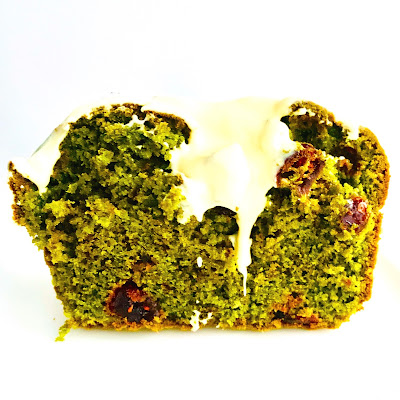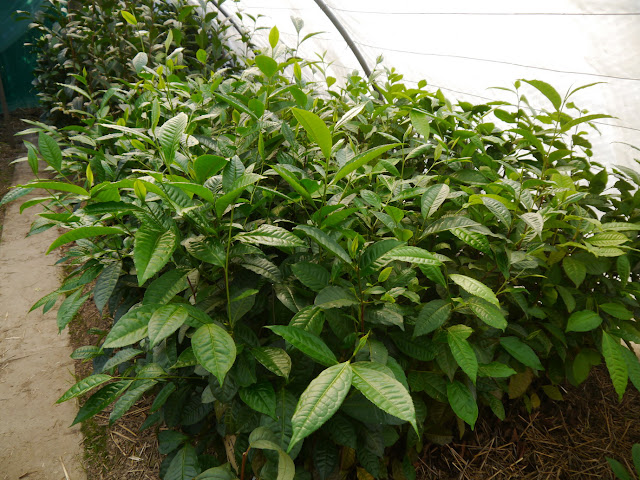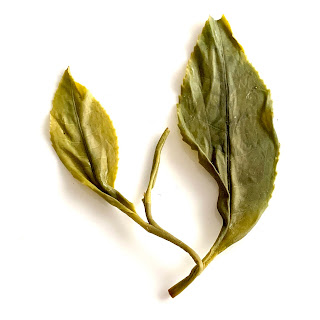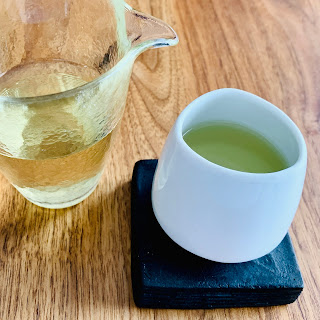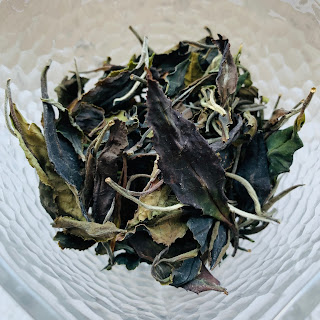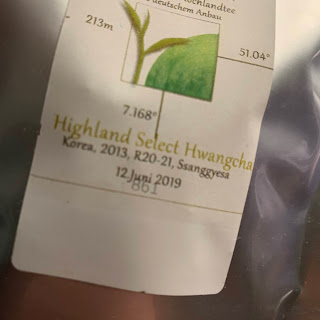Honestly, what do you think about when you hear the term "German tea"? Well, for about 30+ years my prioritization regarding that train of thought went more or less like this:
- Frisian blend* (Ostfriesenmischung) - what my fellow countrymen (m/f/d) first drank in the North-western German region of Easter Frisia, close to the Netherlands - and the North Sea.
- Asian tea imported and blended and/or repackaged by merchants of the German Hanseatic League for distribution across continental Europe.
- Comic euphemism for beer.
At least that was what I attributed German tea with up until about five years ago when I briefly read about a couple which supposedly ran a little tea garden called Tschanara in the village Odenthal-Scheuren (about 20km away from the Cologne Cathedral). Soon after noticing, I already had forgotten about them. I mean, seriously, tea from Germany? Arrogance is bliss, or is it?
While writing my recent book on tea and sampling 1,000+ different teas from 70+ vendors and about two dozen tea growing countries, it never occurred to me to check up on German tea. Guilty as charged, I could have know.
The location
The tea garden lies in a region called Bergisches Land and its produce is called Bergischer Hochlandtee (High mountain tea) which is quite a bold naming. The garden's elevation is 213m (just south of 700ft) which is not exactly "high mountain", but then why is the region called "Bergisch" (mountainous)? There is an easy answer to this question, the former Duchy got its name from the Counts of Berg. But mountains - not that many! Anyhow, the region's highest elevation is 519m and thus it "legally" qualifies as a highland region. So Tschanara called its produce Highland tea in English. Furthermore, the founding couple told me they both fancy Whiskey from certain European highlands, so probably they just cannot get the highlands out of their heads - or palates.
Pubilimba variety in the Tschanara greenhouse ©Tschanara Teagarden
How it began
In the mid-eighties the German Wolfgang Bucher met his future wife Haeng ok Kim while visiting the Ssanggyesa temple in Korea. Being both into tea, they often brought tea seeds back to Germany when traveling in Asia and soon started planting them on half an acre of land more than 20 years ago. Doesn't that happen to all of us? One brings home a flower seedling, plants it in the yard and ends up with about the size of a soccer field full of them. Happens all the time, doesn't it?
Although Wolfgang Bucher has been working in crop sciences, the couple always considered Tschanara as a hobby, so here is a spoiler alert: do not try ordering tea from the Tschanara shop. They do not sell tea - yet. Although this might change in the distant future, they currently run the occasional workshop or tasting session as a hobby project and may be approached regarding these. Also, in case you just cannot stop yourselves from starting a tea garden on your own, you may ask them to sell you some seeds in bulk at what appears way below cost to me. Again, do not bother them for a handful, but if you really own land (not just a garden) and you are serious, they might part with a couple of hundreds of seeds or seedlings every year.
The goal
Tschanara has been given three major goals:
- Quality optimization in producing green, oolong, and black (red) tea.
- Selecting and breeding the best cultivars for the above purpose.
- Breeding cultivars with better frost and drought resistance.
Whilst the climate is mostly mild, there is the occasional frost in the winter with temperatures as low as -15°C, but as long as the roots are being covered with straw so they do not freeze, the plants do not suffer. The leaves might, but this can be managed by determining the ideal time of pruning and such.
Thanks to global warming, frost will very likely become less of an issue in this region, but also due to global warming, water will make itself scarce. Tschanara plans to be prepared.
What Tschanara really is
Why is a tea garden not selling tea? The answer is both easy and rather complex. You can probably imagine how much work it is to plant and care for hundreds of different varieties and cultivars in one garden. I suppose no regular tea farmer would go to these extremes, they rather need to focus on a couple of cultivars in order to produce market-ready amounts of certain teas. Also, the Tschanara owners meticulously study each plant and focus on breeding the plants most resistent to diseases and adapting best to the local climate, terroir, microbiota. Good taste is of course desirable when selecting plants for further use and also breeding for high yield would be an important goal, but first things first. By the way, almost all the Japanese high yield Yabukita** cultivar plants Tschanara had have died by now, not making mass production any easier.
Calling Tschanara a mere tea garden is a bold understatement, if you ask me. I rather see it as a privately run and financed tea research institute***. Their seeds and sometimes seedlings hail from China, Taiwan, Japan, Korea, Vietnam, Laos, Myanmar and many more countries and they do not stop at growing Camellia sinensis var. sinensis and var. assamica, but also do var. formosensis or var. pubilimba etc. Whoever tasted tea made of var. taliensis (quite common in teas from Yunnan) will certainly know how diverse the flavor profile might appear in different varieties.
I bet there are less than a handful places outside Asia and East Africa where you may find such a vast collection of different tea plants, but I will keep looking.
The 2019 harvest did yield a total of less than six kilograms of finished tea and Mrs. Kim had to manually produce more than 125 micro-batches. Obviously, one can hardly put a price tag on that or, in other words, the fair price per gram would currently need to be in the range of the world's finest teas.
Cut to the taste
Patience, young Padawan, I am just getting to that. Originally I intended to only write about the tasting experience, but then I reconsidered. I think it makes little sense to squeeze the tasting notes of 25 teas (of all colors, by the way) in here or throw a table of tea names towards you that you may never ever be able to acquire yourselves. There is no guarantee that Mrs. Kim will use material from a certain bush or group of bushes again next year; and if she does, she may rather produce another kind of tea next year from said material - plus it would not be for sale anyway. Therefore I decided to rather give you a summary of highlights and lowlights (if any).
I did a decent number of tastings on my own, but also shared some with my local TeaNuts posse. One of the teas we sampled was a 2019 Heicha (Sheng-style), made with a Taiwanese large leaf variety. I've got three more Heicha to check, so this is just an interim judgement, also this one did not yet have the chance to develop much postfermented aroma.
I usually do not write about tea that I did not like and rather keep quiet, but in this case I need to state that the owners did not even want to get me any of their Heicha because they are still in trial stage themselves for now. They finally agreed to provide me with some of these in order to shut me up, I guess. 😁
So what was "wrong" with this 2019 Sheng? Nothing much, but we thought it might have been a little flaw in the Sha Qing or kill-green process. Although the visual appearance was like a 10+ year old Sheng, it rather tasted like Mao Cha with little aroma and just a little bitterness - need to try again in a couple of years, I guess.
Mini Sheng style Heicha (45g)
There also was a Zairai (Japanese, planted in 2001) where the dry leaves smelled like Pepsi and the soup a bit like Jin Jun Mei, overall promising more than delivering. Maybe a little bit more oxidation would have been beneficial - just guessing here. Still, whilst a bit weak in taste, it was absolutely okay but not best of breed.
We also had two of the green ones in our recent TeaNuts session, a Sayamakaori (Japanese cultivar, planted in 2001) and a Chaerejeong (Korean seeds, planted in 2013). Not owning steaming equipment one can only achieve so much when trying to create Japanese-like tea taste, and this probably wasn't even Mrs. Kim's intention. Still, the Sayamakaori was to my absolute liking, clearly tasting "Japanese" and easy on the tongue. The group was fine with it, but then the Chaerejeong really rocked! More relaxed, more self-aware, much better and even a fourth steeping still put something into the cups - it does not have to hide behind a Sparrow's Tongue from Korea.
Mrs. Kim being from Korea, one may say "quelle surprise", but she had no formal training in tea production, all her skills are self-taught and her limited equipment and the need to mainly produce micro-batches makes the quality she comes up with even more admirable.
Green tea made in Germany
Two white (assamica) teas (one from Nantou, Taiwan and the other one a blend from Burmese and Laotian bushes, seeds planted in 2016 and 2017, respectively) were also sampled and appeared absolutely market-ready. Nothing to complain - the former very strong, the latter not that much. As I am more into aged but fresh white teas, I would love to taste them again after at least five or seven years of aging, but the minute samples won't even live to see the next month.
White tea made in Germany
And the winner is...
The love song Coldplay supposedly made about Gwyneth Paltrow could well have been the background music for the session's highlight: Yellow. The leaves we already tasted in green had also been made into yellow tea. While I occasionally enjoy the very special taste of high quality yellow teas, I did not expect too much here, especially knowing that some shady tea manufactures still try selling improperly made green as yellow tea.
The Japanese cultivar provided a decent cup, well rounded and delicate, but the genetically Korean Chaerejeong (produced in the slightly different Hwangcha-style) blew all of us off our feet. The unanimous decision was that this was the best yellow tea any of us ever had. Dried flower on top of fresh hay, sweet cotton candy and lychee were just some of our observations. I rated it at three stars in my personal tea database (with three being the highest rating), think Nadia Comăneci or Bo Derek (perfect tens in their respective fields). Wow!
Yellow tea made in Germany
To summarize, I think what Mrs. Kim is able to produce is just amazing. The top batches could easily be offered at north of one Euro per gram.
What else?
It is certainly worth mentioning that Tschanara has never used chemical fertilizers or pesticides, which gives the avid drinker an even better feeling and also lets the teas taste a little similar to others from organic or pesticide-free farms. You know what I mean, don't you? A bit less strong, a little more subtle, sometimes like missing a bit of power while on the other hand appearing more relaxed. Really nice. Even more so as we only made it halfway through the samples, so there is more to steep. Yummy!
Of course one may visit the Cathedral when stopping by in Cologne, but there are options now...
* Think of it as of something similar to English/Scottish/Irish/Welsh breakfast tea, only more befitting the local water quality and taste preferences of the Frisians.
** The most dominant cultivar used in Japan.
*** Humble as the owners appear, they are not calling themselves that. They do not study the plants in a lab or examine their genetic codes, but certainly go beyond pure farming.



